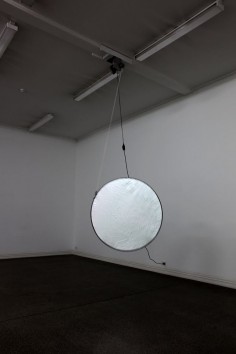ALICIA FRANKOVICH
Man walked on the moon
source: eyecontactsite
The four works by performance artist and ex-gymnast Alicia Frankovich in the downstairs Starkwhite space continue her passionate interest in the human body, its gesture and movement – be that self-generated or manipulated by others. The large gallery and the adjacent office are darkened, presenting two videos, a kinetic sculpture and a photograph. Upstairs there is another set of photographs, and on opening night there was an energetic male go-go dancer (Jumping Man) performing – as did Frankovich herself (and her family) serving delicious pavlova and plums.
No static sculpture or performance residue is included. The moving films and jerking sculpture (a large shiny disc on a string) dominate, the main work being Volution, a short movie made in Berlin featuring jerky editing and referencing the famous boxing fight scene from Charlie Chaplin’s City Lights. In this scene Chaplin constantly hides behind the ref so his opponent can’t hit him, and then adopts a wrestler’s strategy by hurling himself bodily at his rival’s midriff pushing him to the ground.
In Frankovich’s bouncier, more choreographed version the two jigging ‘boxers’ rotate around each other (and spin) throwing absurdly wild punches while the artist acts the role of the mediating referee. Two other people from the street also get involved so the narrative is fanciful and funny. Frankovich then takes on Chaplin’s role by lunging at the bigger opponent so they fall flat on their backs as if knocked out.
On the soundtrack for this film is a little tinkling bell that indicates the changing of rounds. That brittlely delicate sound interacts spasmodically in the room with a loud clanging that comes regularly from a motor attached to the ceiling, and which yanks the disc. The moving metal circle looks like the gong struck by a muscle man at the beginning of J. Arthur Rank movies and suggests an imagined but never heard deeper sound.
The other film, Genet Piece, refers to the great novelist Jean Genet’s imaginative explorations while in prison, and the masturbatory homoerotic fantasies that drove his intensely lyrical writing. Self-absorbed in reverie Frankovich’s dancer performs alone and slowly as if with an invisible lover, his shifting weight repeatedly squeaking a couple of floorboards. The film changes to a view of the dancer lying on his back on the floor shirtless and wearing jeans, as if the object of desire for the vertical fantasiser. Above his crotch near the top button of his fly, one hand suggestively caresses with the forefinger of the other.
By the front door Frankovich’s spot lit photograph of an Egg Happening in Stuttgart is very different. It shows two people each attempting to balance two eggs in a pair of teaspoons clenched in their mouths at once, and seems a variation of the famous running waiters egg-balancing race in Paris, and a couple of egg-tray balancing sculptures Frankovich has exhibited in other shows using chairs and metal door frames. They seem to represent latent movement, not manifest like the bright zigzagging circle skittering backwards and forwards above the floor.
Precarious trays of eggs trying to attain a safe equilibrium on sharp edges are of course symbols for the gymnast’s (performance artist’s) poised body but here only the German photo alludes to them. The films have a different sort of energy, dealing with rotation, vertical bounce and the wonders of comic and erotic imaginations. In this show they have been now been translated into something more anarchically playful, ambiguous, and meditative.
.
.
.
.
.
.
.
.
source: citygallery
Encountering Alicia Frankovich’s installation inevitably evokes her memorable live performances, based around the harnessing, hoisting and suspension of her own body through gymnasium apparatus. The absence of the artist as performer in this
setup is an equally visible part of her more recent work, which often uses the bodies of others or sculptural objects as surrogates. Her non-appearance confounds many of the hallmarks of live performance, denying or deferring the promise of spectacle,
and removing the body—especially the female body—as a site of engagement for the audience. Yet this installation predates Frankovich’s live performances, offering an early articulation of her ongoing interest in objects that come out of actions and actions that come out of objects. Her practice insists that all objects are inherently performative: it is the idea or the possibility of action that is performed here, the sense that something is either soon to happen or has just occurred.
For those familiar with Frankovich’s later work this installation carries traces of the live performances that it in fact anticipates. Eradicating the need for the physical presence of the artist, Frankovich expands the reach of live performance while pushing the potential of static objects to become alive and active. Where her performances test the limitations of the human body, Frankovich’s object-based work challenges sculpture to reach beyond its often self-imposed physical boundaries.
Frankovich’s live performances depend on a trust relationship with the support apparatus to protect against the possibility of failure and injury. The routine becomes a metaphor for the act of making and presenting art within the apparatus of the art
system. Eliminating the physical presence of the artist, Frankovich shifts the dynamic to the audience, to the act of encountering rather than making art, and to the spaces
in which this encounter is performed. Testing the audience’s trust relationship with the objects they meet in the gallery, Frankovich re-energises what has always been the privileged domain of sculpture: the possibilities found in the physical encounter with an object in real space and real time.


